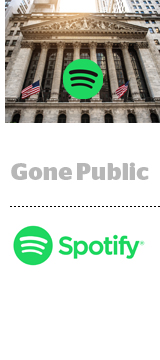
Spotify filed its F-1 with the US Securities and Exchange Commission on Wednesday, forgoing a traditional IPO for a direct listing on the New York Stock Exchange. Read the filing.
The direct listing means Spotify can directly post its shares on the stock exchange rather than going through the traditional process of hiring a bank as an underwriter.
Spotify reported revenues of $5 billion for 2017. Ad revenue was up 41% to $147 million, due to a 31% increase in number of impressions sold programmatically and a 7% increase in the average rate per impression, the company said. However, Spotify lost a significant amount of money last year – $1.5 billion – to music rights costs.
While subscription revenues represented 90% of total revenue at the company since 2016 (subscribers grew 46% last year to 71 million), Spotify is still focused on growing its ad-supported channel as “a strong and viable stand-alone product with considerable long-term opportunity for growth,” the filing read. Ad-supported services drove 60% of subscription sign-ups in 2017.
Much of that ad-supported revenue growth will be driven by programmatic. Programmatic accounted for 49% of impressions Spotify sold in 2017, making up 18% of ad-supported revenue. Programmatic revenues were up 100% year over year in 2017.
“Offering advertisers additional ways to purchase advertising on a programmatic basis is a key way that we intend to expand our portfolio of advertising products and enhance advertising revenue,” the company said. “By offering advertisers increased ‘self-serve options,’ we expect to improve the efficiency and scalability of our advertising platform.”
Premium video is also a boon for the company, growing 74% in 2017 to fuel 29% of Spotify’s ad-supported revenue.
The streaming music platform has 159 million monthly active users (MAUs) and 71 million premium subscribers (up 46% from 2016). Ad-supported MAUs were up 19% to 92 million from 2016.
Average revenue per user (ARPU) for subscribers was $7.60, down 14% from 2016. Spotify did not break out ARPU for ad-supported users.
Spotify said it has a 42% share of the global streaming market by revenue but is keenly aware of competition in the music-streaming market, listing it as a risk factor in the filing.
“We face intense competition in growing both our ad-supported users and premium subscribers, as well as in keeping our users highly engaged,” the filing read. “If user engagement declines or if we fail to continue to grow our ad-supported user base or premium subscriber base, our revenue growth will be negatively impacted.”
This post was syndicated from Ad Exchanger.

More Stories
VML launches ‘Conquer the Weekend’ campaign for Ford
The Latest CMA Report Brings New Privacy Concerns to Google’s Cookie Deprecation Plans
Comic: The Curated Marketplace